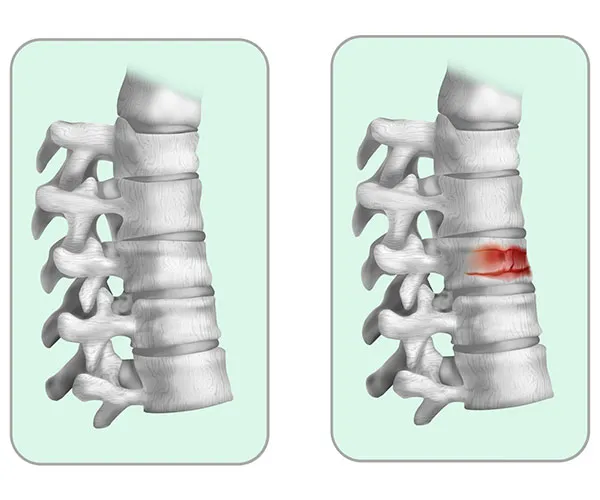

Now offering Primary Care services under Apex Primary Wellness! Schedule your visit today.
A compression fracture occurs due to cracks or breakages in the vertebral bone. Over time, it may cause your spine to weaken and collapse, leading to severe pain, body deformity, and limited mobility.
This condition mostly occurs in the thoracic spine region or the middle of the back, especially in the lower thoracic area, leading to pain in the middle or lower back. Compression fractures, also known as vertebral compression fractures (VCF), are mostly seen among post-menopausal women, but they are also a serious health concern for older men.
With the right compression fracture vertebrae treatment in Coppell, Carrollton, Grapevine, TX, and surrounding areas, you can enjoy a pain-free quality of life that allows greater mobility and improved posture.
A compression fracture, in its initial stages, may not show any symptoms, but as it progresses, you may experience the following:
The pain usually starts suddenly and continues for a long time. While lying down may offer relief, standing or walking may worsen the pain.
You may find bending or twisting your body difficult due to reduced spinal flexibility.
The spine compresses, and its length reduces, causing height loss. Vertebrae collapse may also impact your height.
The shape of the spine changes resulting in a hunched appearance called Dowager’s Hump or kyphosis. This occurs as the front side of the vertebrae compresses and the rear side is unaffected.

The most common cause of compression fractures is osteoporosis, a condition in which the bones become porous and brittle.
For people with moderate osteoporosis, mild to strenuous physical activity, such as lifting heavy objects or falling, may lead to a compression fracture. However, if you have severe osteoporosis, you may suffer a compression fracture even while performing simple daily activities, such as stepping out of a shower and lifting light objects to sneezing and coughing.
The other causes of this condition, as seen in younger patients or those who do not have osteoporosis, include:
You may be at most risk for compression fractures if you have:
Osteoporosis is a disease that deteriorates bone health, causing it to break more often. While women are more likely to have osteoporosis, your risk factor increases if you are:
Older men, too, are prone to developing osteoporosis and compression fractures.
Also, if you have had an osteoporosis-induced compression fracture earlier, you are at a higher risk of having other fractures in the future.
Cancer that spreads to the vertebrae weakens the bones of the vertebrae and causes them to break easily, making you more vulnerable to compression fractures.

Your doctor will perform several tests to diagnose your compression fracture accurately. They include:
Depending on the type of fracture and its probable cause, your compression fracture vertebrae treatment options may include:
At Apex Interventional Pain & Spine, Dr. Mohammed I. Khan, a board-certified physician in physical medicine and rehabilitation and pain management, and his team offer a wide range of minimally invasive interventional pain procedures and multimodal pain solutions for a broad spectrum of pain conditions in Coppell, Carrollton, Grapevine, TX, and surrounding areas.
Our commitment to providing a pain-free life for our patients suffering from compression fractures drives our team to offer personalized, tailored treatment plans, including specialized care for cracked vertebrae in elderly patients.
A few highlights of our exceptional services are:
Have you been experiencing severe back pain that has adversely affected your movement, flexibility, and body posture? Contact us at Apex Interventional Pain & Spine today at Coppell, Carrollton, and Grapevine, TX, to learn more about our treatment for compressed fractured vertebrae or to schedule an appointment.